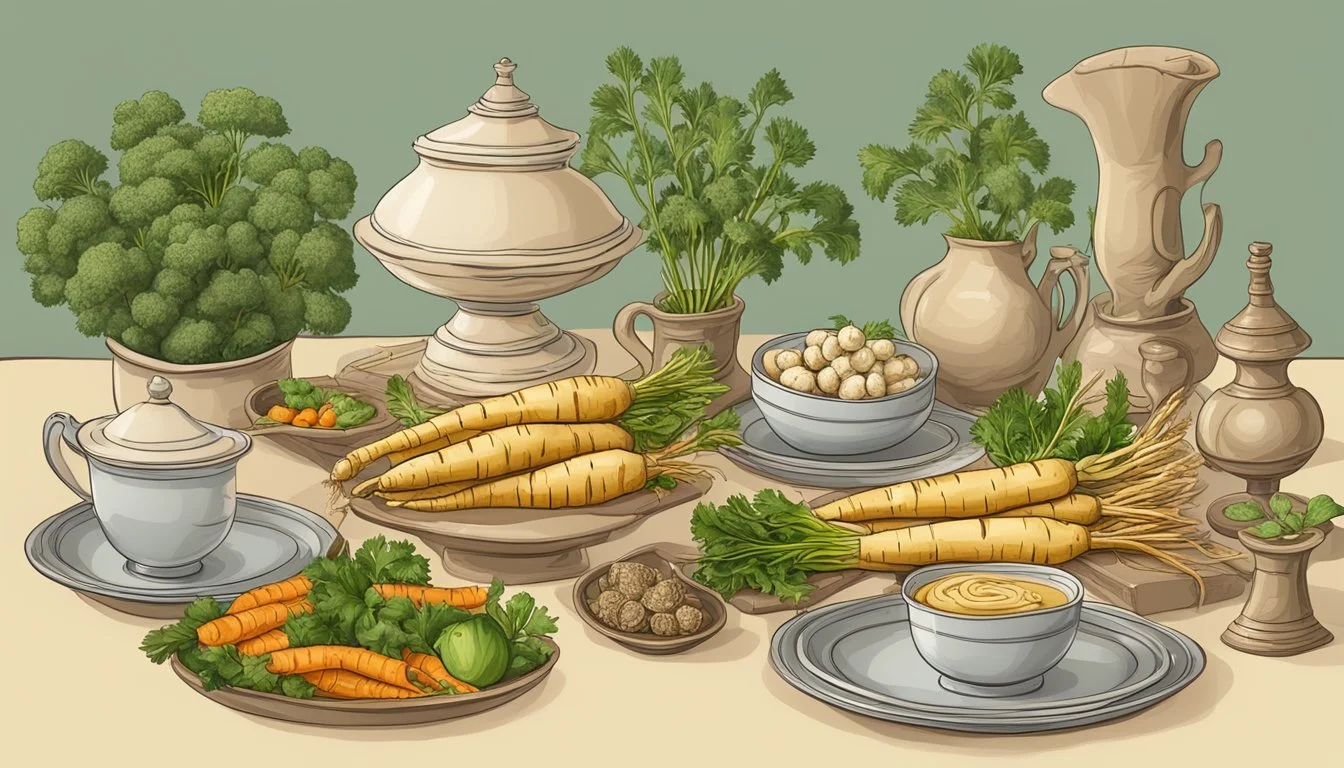What are the Health Benefits of Parsnips?
Unveiling Nutritional Advantages
Parsnips, a root vegetable closely related to carrots and parsley, have long been valued for their versatility in the kitchen and the array of health benefits they offer. Creamy white in appearance and sweet to taste when cooked, these vegetables have a distinctive flavor and texture that enriches a variety of dishes. They are a winter staple in many parts of the world and come packed with essential nutrients beneficial for maintaining overall health.
Rich in vitamins and minerals, parsnips contain high levels of important antioxidants such as vitamin C, which plays a crucial role in the body’s ability to prevent oxidative stress and support the immune system. The fibrous nature of this root vegetable contributes to digestive health, while the presence of potassium and other heart-healthy nutrients helps to improve cardiovascular wellness. Parsnips are also noted for their potential in aiding weight management due to their low-calorie yet high dietary fiber content.
Nutritional Profile of Parsnips
Parsnips are a nutrient-dense root vegetable, providing a wealth of vitamins and minerals along with important macronutrients. Their rich nutritional profile supports various health benefits.
Vitamins and Minerals
Parsnips are an excellent source of several vitamins and minerals essential for good health. They are particularly high in Vitamin C, a potent antioxidant that aids in immune function and skin health. Here's a breakdown of some key micronutrients:
Vitamin C: A half-cup serving contains about 17 milligrams, around 28% of the daily recommended intake.
Folate: Important for DNA synthesis and preventing birth defects.
Vitamin K: Contributes to bone health and wound healing.
Vitamin E: Helps protect cells from oxidative damage.
Vitamins B6 and Thiamin: Crucial for energy metabolism and brain function.
Iron: Essential for blood production.
Calcium and Magnesium: Vital for bone health.
Potassium: Helps regulate blood pressure.
Zinc and Phosphorus: Support immune health and repair of body tissues.
Manganese: Involved in the metabolism of amino acids, cholesterol, glucose, and carbohydrates.
Riboflavin, Niacin, and Pantothenic Acid: Play roles in energy production and overall cellular function.
Macronutrient Composition
Regarding macronutrients, parsnips contain a harmonious balance that contributes to their health benefits. A detailed view of their macronutrient content is as follows:
Calories: Low in calories, making them a good choice for weight management.
Carbohydrates: High in carbohydrates, including dietary fiber, which promotes digestive health and can help regulate blood sugar levels.
Protein: Offer a modest amount of protein.
Fat: Contain very little fat, which is mostly unsaturated and considered heart-healthy.
By understanding the detailed nutritional profile of parsnips, individuals can appreciate how incorporating this vegetable into their diet can contribute to overall nutrition and well-being.
Health Benefits of Parsnips
Parsnips, a root vegetable related to the carrot and parsley root, offer a range of health benefits due to their rich nutrient profile. They are particularly noted for their dietary fiber, essential vitamins, and minerals that support various bodily functions.
Digestive Health
Parsnips are a good source of dietary fiber, which is essential for maintaining a healthy digestive system. Fiber helps to bulk up stools, facilitate easier digestion, and prevent constipation. Regular consumption of parsnips can aid in the promotion of digestive regularity and may contribute to long-term digestive health.
Heart Health
This vegetable contributes positively to heart health. High in fiber, parsnips help in managing cholesterol levels, potentially reducing the risk of heart disease. They also contain potassium, which is key in regulating blood pressure. Together, these nutrients work to protect the heart and maintain a healthy cardiovascular system.
Anti-Inflammatory and Immune Support
Parsnips contain antioxidants and polyacetylenes, compounds that exhibit anti-inflammatory properties. These substances can help to reduce inflammation in the body, supporting overall health. Additionally, with a good content of vitamin C, parsnips play a role in bolstering the immune system and guarding against various ailments, potentially including cancer. Their anti-inflammatory effects and immune support are integral to the myriad health benefits parsnips provide.
Culinary Uses and Preparation
Parsnips' versatility in the kitchen is notable due to their distinct sweet flavor and creamy white color. When cooked, they develop a richer sweetness and can be prepared using various methods to complement a wide range of dishes.
Cooking Methods
Parsnips can be roasted in the oven to enhance their natural sweetness, resulting in a caramelized exterior with a tender inside. For boiling, they soften considerably, making them ideal for purees or to be mixed into stews for added thickness. Boiled parsnips can also be mashed, similar to potatoes, often including cream or butter for a smooth texture. Additionally, parsnips are excellent when fried, providing a crispy alternative to traditional fries.
Roasted: Preheat the oven to 425°F (220°C), and roast chopped parsnips for about 25-30 minutes.
Boiled: Cut into chunks and boil in salted water for 15-20 minutes until tender.
Fried: Slice into thin strips, and deep-fry in oil until golden brown and crispy.
Recipe Suggestions
Parsnips can be incorporated into a variety of recipes, from soups and stews to casseroles and salads:
Soups and Stews: Add diced parsnips for a subtle sweet flavor and hearty texture.
Casseroles: Mix sliced parsnips with other root vegetables, and bake in a cream sauce.
Salads: Roasted or boiled parsnips can be cooled and added to salads for a touch of sweetness.
Oven-Baked: Combine with carrots and other vegetables, toss with olive oil, and bake until tender.
When using parsnips in cooking, they can act as the main highlight in a dish or serve as a complementary side, pairing well with a variety of flavors and ingredients.
Historical and Cultural Significance
Parsnips, understood through historical texts and agricultural practices, hold noteworthy prominence in European and North American culinary and cultural traditions. This edible root vegetable, often compared to its relatives the carrot and parsley root, carries a tapestry of historical relevance that intertwines with the spread of agriculture across countries and continents.
Origins and Spread
Parsnips (Pastinaca sativa) have been cultivated since antiquity, with their origins tracing back to Eurasia. These pale, cream-colored roots were a staple before the introduction and popularity of the potato.
Eurasia: The parsnip is indigenous to Eurasia. It was a common food item since Roman times, valued for its sweetness and hardiness.
Europe: In medieval Europe, parsnips were part of the staple diet and were consumed throughout the winter months when other food sources were scarce. They were commonly roasted or used in stews and soups.
Spread to North America: Parsnips were brought to North America by European settlers. The vegetable adapted well to the continent's varying climates, becoming a familiar crop in kitchen gardens.
It's important to note that throughout their cultivation history, parsnips were not just food. The roots were sometimes considered a remedy, believed to hold medicinal properties. In terms of cultural significance, parsnips sometimes appear in folklore and old wives' tales, representing endurance and resilience because of their ability to withstand tough winters.
Frequently Asked Questions
Parsnips are root vegetables known for their distinctive sweet flavor and impressive nutritional profile. This section addresses common inquiries about their health benefits.
How can parsnips contribute to skin health?
They contain vitamins and minerals which play a role in maintaining good skin health, including vitamin C, which is essential for collagen production and skin repair.
Is there a connection between parsnips and cancer prevention?
While no food can guarantee cancer prevention, parsnips have antioxidants that may lower the risk of certain cancers by combating free radicals in the body.
What is the nutritional value of parsnips per 100g?
Per 100 grams, parsnips provide approximately 75 calories, 18 grams of carbohydrates, 3.5 grams of fiber, and are a good source of vitamin C, potassium, and folate.
Can consuming parsnips aid in weight loss efforts?
Parsnips are high in fiber which can aid in weight loss by promoting a feeling of fullness and regulating blood sugar levels, leading to reduced overall calorie intake.
What potential side effects should one be aware of when eating parsnips?
Some individuals may experience an allergic reaction to parsnips. Additionally, parsnips contain psoralens, which can cause skin sensitivity when exposed to sunlight.
How do the health benefits of parsnips compare to those of potatoes?
Parsnips typically have a lower glycemic index than potatoes and a higher content of dietary fiber, making them a potentially better choice for blood sugar control. However, both vegetables offer valuable nutrients.





